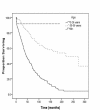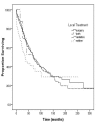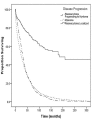Skeletal Plasmacytoma: progression of disease and impact of local treatment; an analysis of SEER database
- PMID: 19778427
- PMCID: PMC2759950
- DOI: 10.1186/1756-8722-2-41
Skeletal Plasmacytoma: progression of disease and impact of local treatment; an analysis of SEER database
Abstract
Background: Previous reports suggest an as yet unidentifiable subset of patients with plasmacytoma will progress to myeloma. The current study sought to establish the risk of developing myeloma and determine the prognostic factors affecting the progression of disease.
Methods: Patients with plasmacytoma diagnosed between 1973 and 2005 were identified in the SEER database(1164 patients). Patient demographics and clinical characteristics, treatment(s), cause of death, and survival were extracted. Kaplan-Meier, log-rank, and Cox regression were used to analyze prognostic factors.
Results: The five year survival among patients initially diagnosed with plasmacytoma that later progressed to multiple myeloma and those initially diagnosed with multiple myeloma were almost identical (25% and 23%; respectively). Five year survival for patients with plasmacytoma that did not progress to multiple myeloma was significantly better (72%). Age > 60 years was the only factor that correlated with progression of disease (p = 0.027).
Discussion: Plasmacytoma consists of two cohorts of patients with different overall survival; those patients that do not progress to systemic disease and those that develop myeloma. Age > 60 years is associated with disease progression. Identifying patients with systemic disease early in the treatment will permit aggressive and novel treatment strategies to be implemented.
Figures
Similar articles
-
Plasma Cell Myeloma - 20-Year Comparative Survival and Mortality of Three Plasma Cell Myeloma ICD-O-3 Oncologic Phenotypes by Age, Sex, Race, Stage, Cohort Entry Time-Period and Disease Duration: A Systematic Review of 111,041 Cases for Diagnosis Years 1973-2014: (SEER*Stat 8.3.4).J Insur Med. 2018;47(4):203-211. doi: 10.17849/insm-47-04-1-9.1. Epub 2019 Jan 22. J Insur Med. 2018. PMID: 30668210
-
Solitary plasmacytoma of bone: clinical features, treatment and survival.Hematol Oncol. 1992 May-Aug;10(3-4):207-11. doi: 10.1002/hon.2900100311. Hematol Oncol. 1992. PMID: 1398516
-
Retrospective analysis of plasmacytoma in Kansai Myeloma Forum Registry.Int J Hematol. 2020 Nov;112(5):666-673. doi: 10.1007/s12185-020-02961-3. Epub 2020 Aug 11. Int J Hematol. 2020. PMID: 32783165
-
Solitary plasmacytoma: population-based analysis of survival trends and effect of various treatment modalities in the USA.BMC Cancer. 2017 Jan 5;17(1):13. doi: 10.1186/s12885-016-3015-5. BMC Cancer. 2017. PMID: 28056880 Free PMC article.
-
Solitary plasmacytoma of bone and asymptomatic multiple myeloma.Hematol Oncol Clin North Am. 1992 Apr;6(2):359-69. Hematol Oncol Clin North Am. 1992. PMID: 1582978 Review.
Cited by
-
The Diagnosis and Treatment of a Rare Maxillary Plasmacytoma: a Case Report.J Dent (Shiraz). 2020 Sep;21(3):239-243. doi: 10.30476/DENTJODS.2019.77839.. J Dent (Shiraz). 2020. PMID: 33062819 Free PMC article.
-
An overview of multiple myeloma: A monoclonal plasma cell malignancy's diagnosis, management, and treatment modalities.Saudi J Biol Sci. 2024 Feb;31(2):103920. doi: 10.1016/j.sjbs.2023.103920. Epub 2023 Dec 30. Saudi J Biol Sci. 2024. PMID: 38283805 Free PMC article. Review.
-
Multiple solitary plasmacytoma with multifocal bone involvement. First clinical case report in a uraemic patient.BMJ Case Rep. 2013 May 23;2013:bcr2013009157. doi: 10.1136/bcr-2013-009157. BMJ Case Rep. 2013. PMID: 23709144 Free PMC article. Review.
-
Prediction of Solitary Plasmacytoma of Bone in Elderly Patients: A Nomogram and a Risk Classification System for Overall Survival.Biomed Res Int. 2022 Jun 1;2022:7387416. doi: 10.1155/2022/7387416. eCollection 2022. Biomed Res Int. 2022. PMID: 35692586 Free PMC article.
-
Mandibular plasmacytoma of jaw - a case report.J Clin Diagn Res. 2014 Aug;8(8):ZD20-1. doi: 10.7860/JCDR/2014/9565.4674. Epub 2014 Aug 20. J Clin Diagn Res. 2014. PMID: 25302275 Free PMC article.
References
-
- Dimopoulos MA, Moulopoulos LA, Maniatis A, Alexanian R. Solitary plasmacytoma of bone and asymptomatic multiple myeloma. Blood. 2000;96:2037–2044. - PubMed
-
- Ozsahin M, Tsang RW, Poortmans P, Belkacemi Y, Bolla M, Dincbas FO, Landmann C, Castelain B, Buijsen J, Curschmann J, et al. Outcomes and patterns of failure in solitary plasmacytoma: a multicenter Rare Cancer Network study of 258 patients. Int J Radiat Oncol Biol Phys. 2006;64:210–217. - PubMed
-
- Tong D, Griffin TW, Laramore GE, Kurtz JM, Russell AH, Groudine MT, Herron T, Blasko JC, Tesh DW. Solitary plasmacytoma of bone and soft tissues. Radiology. 1980;135:195–198. - PubMed
-
- Galieni P, Cavo M, Avvisati G, Pulsoni A, Falbo R, Bonelli MA, Russo D, Petrucci MT, Bucalossi A, Tura S. Solitary plasmacytoma of bone and extramedullary plasmacytoma: two different entities? Ann Oncol. 1995;6:687–691. - PubMed
Publication types
MeSH terms
LinkOut - more resources
Full Text Sources
Medical




